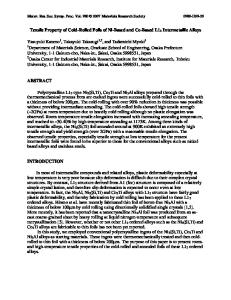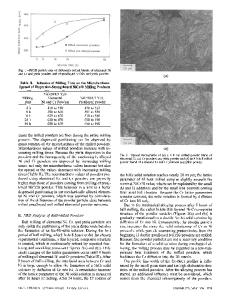Exploratory study of elevated temperature tensile properties of alloys based on the intermetallic compound tini
- PDF / 582,264 Bytes
- 6 Pages / 612 x 783.28 pts Page_size
- 4 Downloads / 362 Views
T H E upper t e m p e r a t u r e for the useful application of c o m m e r c i a l titanium a l l o y s in turbine engines is in the vicinity of 750 K (890~ The most r e c e n t e x p e r i mental a l l o y s have r a i s e d this t e m p e r a t u r e l i m i t to somewhat above 800 K (980~ but c o n s i d e r e d as a whole, the v a r i o u s strength p r o p e r t i e s of titanium a l loys begin to d e g r a d e r a p i d l y above 750 K (890~ Below this t e m p e r a t u r e the strength p r o p e r t i e s g e n e r a l l y d e c r e a s e only m o d e r a t e l y with i n c r e a s i n g t e m p e r a t u r e . The effect of this l i m i t a t i o n can be seen in t h e m a t e r i a l s c o n s i d e r e d for the b l a d e s of the v a r i o u s comp r e s s o r s t a g e s of a ten stage advanced turbine engine, which a r e subjected to t e m p e r a t u r e s between a p p r o x i m a t e l y 500 and 900 K (440 and l160~ depending on the stage. Up through stage six, near 750 K (890~ the titanium alloy s e l e c t e d has useful c r e e p strength. Above this t e m p e r a t u r e , however, a n i c k e l - b a s e s u p e r alloy must be used. The c r e e p strength of the nickel alloy is f a r in e x c e s s of that of the titanium alloy. In fact, the strength is so much g r e a t e r that even when n o r m a l i z e d with r e s p e c t to specific g r a v i t y at 850 K (1070~ the nickel a l l o y used has four t i m e s the c r e e p strength of the titanium alloy. Unfortunately, the nickel alloy has a specific g r a v i t y a l m o s t twice that of the t i tanium alloy (8 vs 4.5), r e s u l t i n g in both a g r e a t e r blade s t r e s s due to centrifugal loading and a s i g n i f i cantly higher engine weight. Thus, though it entails a weight penalty, the n i c k e l b a s e a l l o y s must be used in the l a t t e r s t a g e s of the c o m p r e s s o r b e c a u s e of the inadequate strength of t i tanium a l l o y s . Moreover, the use of titanium a l l o y s is f u r t h e r complicated by the s u s c e p t i b i l i t y of titanium to oxygen contamination above a p p r o x i m a t e l y 850 K (1070~ In light of the above c o n s i d e r a t i o n s , a different type of p o s s i b l e blade m a t e r i a l for the l a t t e r s t a g e s of a c o m p r e s s o r was studied, an i n t e r m e t a l l i c compound. Only one i n t e r m e t a l l i c compound with useful ductility has been studied in any detail, the equiatomic compound TiNi. This compound has a specific g r a v i t y of 6.45, inMARVIN GARFINKLE,formerly with NASA LewisResearch Center, Cleveland,Ohio 44135, is now with Helicorporation, Philadelphia,Pa. 19124 Manuscript submitted January 16, 1974. METALLURGICALTRANSACTIONS
t e r m e d l a t e between titanium and nickel. TiNi has been studied in detail by many i n v e s t i g a t o r s p r i m a r i l y b e cause of its unique m e m o r y p r o p e r t i e s , which a r e a s sociated with a low t e m p e r a t u r e m a r t e n s i t i c t r a n s f o r mation with the M
Data Loading...











